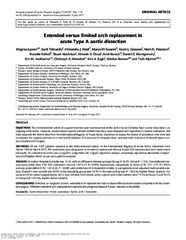| dc.contributor.advisor | Myrmel, Truls | |
| dc.contributor.author | Larsen, Magnus | |
| dc.date.accessioned | 2018-08-27T08:26:58Z | |
| dc.date.available | 2018-08-27T08:26:58Z | |
| dc.date.issued | 2018-06-20 | |
| dc.description.abstract | <p><i>Background/aims:</i> Acute aortic dissection (AAD) is a rare life-threatening disease that does not easily lend itself
to randomized controlled trials. Data regarding the effect of treatment advances in the recent
decades is limited. Determinants of follow-up mortality are poorly understood. To include
many patients and evaluate contemporary management of AAD, the International Registry of
Acute Aortic Dissection (IRAD) was established in 1996. This work was undertaken to
examine factors associated with morbidity and mortality after an AAD – specifically whether
a partial thrombosis of the false lumen is a negative prognostic marker in type A AAD
(AAAD), whether an open distal anastomosis confer prognostic benefit in AAAD surgery and
finally whether the aortic arch should be resected at initial surgery for AAAD. Furthermore,
we assessed the changes in management and outcomes of patients with AAAD over time.<p>
<p><i>Methods:</i> Data collected in the IRAD since 1996 was used for analyzes. A literature search was done to
evaluate the existing evidence for an open distal anastomosis in AAAD surgery.<p>
<p><i>Results/conclusions:</i> A partial thrombosis of the false lumen was not associated with increased mortality, aortic
growth or re-intervention in the follow-up period after an AAAD. Patients with an AAAD
who survive the acute event have a favorable mid-term prognosis. Over time, a decrease in inhospital
mortality was seen in AAAD, but not in type B AAD. More patients with AAD are
managed with interventional procedures in the current era. An extended arch resection in
AAAD has no discernable acute downside compared with less extensive surgery. Finally,
based on the available literature, the data to support either an open or a closed distal
anastomosis in AAAD is insufficient, and the surgical management of AAAD should be
based in individual and aortic-specific assessment and take the patient’s age, comorbidities
and preoperative clinical condition into account.<p> | en_US |
| dc.description.doctoraltype | ph.d. | en_US |
| dc.description.popularabstract | Factors that determine the long-term prognosis after an acute aortic dissection (AAD) are poorly understood. We have used the available literature and an international acute aortic dissection registry (IRAD) to evaluate certain factors’ influence on outcome. Also, trends in the management and outcome of AAD were examined. We found that the presence of clotted blood in the so-called false lumen in an AAD did not influence the prognosis. The extent of aortic resection during surgery for AAD did not influence short- or long-term outcome. Whether the construction of the “distal anastomosis”, which is the connection between the prosthetic vascular graft and the patient’s aorta, is done with a clamp on the aorta or in hypothermic circulatory arrest, should be determined by each surgeon and to a certain extent based on the patient’s age and life expectancy. The treatment of AAD has changed in the last two decades with more patients being treated with surgical therapies in the current era. | en_US |
| dc.description.sponsorship | Nasjonalforeningen for folkehelsen | en_US |
| dc.description | <p>Paper II is not available in Munin</p>
<p>Paper II: Myrmel T, Larsen M, Bartnes K. (2014). Does an Open Distal Anastomosis Confer Prognostic
Benefit in Acute Dissection Surgery? In: Bonser, R.S., Pagano, D., Haverich, A., Mascaro, J. (eds). Chapter in <a href=https://doi.org/10.1007/978-1-4471-5622-2_14>Controversies in Aortic Dissection and Aneurysmal Disease. Springer, London. </a>
<p>Appendix I is not available in Munin</p>
<p>Appendix I: Myrmel, T., Larsen, M. & Bartnes, K. (2016). The International Registry of Acute Aortic Dissections
(IRAD) – experiences from the first 20 years. Available in <a href=https://doi.org/10.1080/14017431.2016.1240829>Scandinavian Cardiovascular Journal, 50(5-6), 329-333.</a> | en_US |
| dc.identifier.uri | https://hdl.handle.net/10037/13597 | |
| dc.language.iso | eng | en_US |
| dc.publisher | UiT The Arctic University of Norway | en_US |
| dc.publisher | UiT Norges arktiske universitet | en_US |
| dc.rights.accessRights | openAccess | en_US |
| dc.rights.holder | Copyright 2018 The Author(s) | |
| dc.rights.uri | https://creativecommons.org/licenses/by-nc-sa/3.0 | en_US |
| dc.rights | Attribution-NonCommercial-ShareAlike 3.0 Unported (CC BY-NC-SA 3.0) | en_US |
| dc.subject | VDP::Medisinske Fag: 700::Klinisk medisinske fag: 750::Kar- og thoraxkirurgi: 782 | en_US |
| dc.subject | VDP::Medical disciplines: 700::Clinical medical disciplines: 750::Vascular and thoracic surgery: 782 | en_US |
| dc.title | Prognosis in acute aortic dissection. Insights from the International Registry of Acute Aortic Dissection | en_US |
| dc.type | Doctoral thesis | en_US |
| dc.type | Doktorgradsavhandling | en_US |


 English
English norsk
norsk



